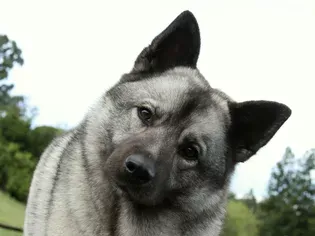Norwegian Elkhound: Dog Breed Characteristics & Care
Updated on 05/27/24

Unveiling the Norwegian Elkhound: A Majestic Breed with Unwavering Loyalty and a Spirit of Adventure
With its striking silver coat, piercing blue eyes, and a disposition that's equal parts playful and protective, the Norwegian Elkhound is a captivating companion that has been turning heads for centuries. In this comprehensive guide, we delve deep into the captivating world of these majestic canines, exploring their breed characteristics, captivating history, and the essentials of their care, to provide you with an in-depth understanding of what makes this breed so exceptional.
1. Breed Characteristics: A Symphony of Strength, Agility, and Affection
1.1 Majestic Appearance: A Striking Silhouette
The Norwegian Elkhound is a medium-sized breed, standing between 19-20 inches at the shoulder and weighing 44-55 pounds. Their most distinctive feature is their stunning double coat, which consists of a thick, coarse outer layer and a soft, dense undercoat that keeps them warm even in the harshest of conditions. The predominant color of the coat is a silvery gray, often with darker guard hairs that create a unique grizzle effect.
1.2 Exceptional Agility: Born Explorers
With their muscular build and athletic frame, Norwegian Elkhounds were bred for endurance and agility. They are renowned for their ability to traverse rough terrain with ease, making them ideal companions for outdoor enthusiasts. Their agility also shines through in their playful nature, as they love to chase, jump, and explore their surroundings.
1.3 Unwavering Loyalty: A Devoted Family Member
Norwegian Elkhounds are deeply loyal and affectionate dogs that bond strongly with their family. They are protective of their loved ones and will always be there to greet you with a wagging tail and a gentle nudge. Their loyalty extends to other pets in the household, and they can coexist peacefully with cats and other dogs.
2. History and Origin: A Proud Heritage
2.1 Ancient Roots: The Viking's Companion
The Norwegian Elkhound's lineage can be traced back to ancient Scandinavia, where they were highly valued by the Vikings. These intrepid dogs were used for hunting large game, such as elk and moose, and their keen senses and tenacity made them invaluable members of the hunting party. Their bond with the Vikings was so strong that they were often buried alongside their masters, a testament to their unwavering loyalty.
2.2 Modern Evolution: A Versatile Breed
Over the centuries, the Norwegian Elkhound's role has evolved from a hunting companion to a beloved family pet. Their versatility and intelligence have made them popular in a variety of disciplines, including agility, obedience, and even herding. They excel in these activities, showcasing their natural athleticism and trainability.
3. Care and Maintenance: A Commitment to Well-being
3.1 Grooming: Maintaining a Pristine Coat
The Norwegian Elkhound's thick double coat requires regular grooming to keep it healthy and free of mats. Brushing several times a week is essential to remove loose hair and prevent tangles. Bathing should be done only when necessary, as excessive bathing can strip the coat of its natural oils.
3.2 Exercise: Fueling an Adventurous Spirit
Norwegian Elkhounds are highly active dogs that require plenty of exercise to stay happy and healthy. Daily walks or runs are a must, and they also enjoy participating in interactive games, such as fetch or hide-and-seek. Providing them with ample opportunities to explore and engage in physical activity is crucial for their well-being.
3.3 Nutrition: A Balanced Diet
A high-quality diet is essential for maintaining the Norwegian Elkhound's health and vitality. Choose a diet that is specifically formulated for active breeds and contains a balance of protein, carbohydrates, and fats. Avoid feeding table scraps or processed foods, as these can lead to weight gain and other health issues.
3.4 Health: Promoting a Long and Healthy Life
Norwegian Elkhounds are generally healthy dogs, but like all breeds, they are prone to certain health conditions. Regular veterinary check-ups are crucial for early detection and treatment of any potential issues. Some common health concerns to be aware of include hip dysplasia, elbow dysplasia, and bloat.
4. Training and Socialization: Nurturing Intelligence and Confidence
4.1 Early Socialization: Building a Well-Adjusted Dog
Early socialization is essential for the Norwegian Elkhound's development into a confident and well-adjusted adult dog. Exposing them to different people, places, and experiences from a young age helps them learn how to interact appropriately with the world around them. Puppy socialization classes are a great way to start this process.
4.2 Positive Reinforcement Training: Encouraging Good Behavior
Norwegian Elkhounds are intelligent dogs that respond well to positive reinforcement training. Use treats, praise, and play as rewards for desired behaviors, and avoid harsh punishment or negative reinforcement. Consistency and patience are key to successful training.
5. Conclusion: A Timeless Companion for the Discerning Dog Lover
The Norwegian Elkhound is a truly exceptional breed that embodies loyalty, agility, and adventure. Their captivating appearance, unwavering devotion, and trainability make them
Explore More Pets

Basic Training
Puppy and Baby Introductions

Working Dog Breeds
All About Search and Rescue Dogs

Dog Treatments
Puppy Vaginitis: Signs, Causes and Treatment

Dog Adoption
After More Than 1,200 Days in the Shelter, Coco Goes Home

Basic Training
How to Train Your Puppy to Go on Potty Pads

Hybrid Dog Breeds
The Difference Between a Mutt, Mixed Breed, or Designer Dog?

Dog Treatments
Nail Problems in Dogs

Puppies
7 Reasons Why Two Dogs Are Better Than One
